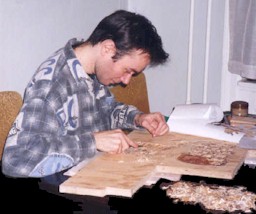The Puzzleglyph Monoliths of Rtiydiuy
In the Jeggulek mountains on the small world of Rtiydiuy in the galaxy of Nemmelgeb Murr stand a pair of 1.7 billion year-old monoliths not unlike the monoliths of the Maya or Stonehenge here on Earth. The pair have puzzleglyphs carved on them, but unlike the monoliths of the Maya whose glyphs reveal dates and inscriptions, the glyphs on the Rtiydiuy monoliths are puzzle pieces. The point is not to assemble the given pieces, yet the monoliths have a single shared solution. At the base of the monoliths sits the statue of a smiling PjjjtHoo, a giant frog-like creature of Rtiydiuy. Whether it is smiling encouragement or laughing at the would-be decipherer is difficult to say.
The culture of Rtiydiuy is based on puzzles, and “puzzle theory” is the central subject upon which all other subjects are based. The children are well-prepared for the ritual they will undertake to become an adult. Upon reaching puberty each child on Rtiydiuy undertakes the “Zhhhhlotl” or puzzle quest.
The Zhhhhlotl is a lonely journey through a purifying desert and into the jungle of the Jeggulek mountains. The first puzzle is to survive the journey (survival is considered the most important puzzle on Rtiydiuy, the one that needs to be continually solved). The second is to find the Puzzleglyph Monoliths (a series of puzzles help point the way). The third is to discover how to go about solving the Puzzle of the Monoliths, which is probably more difficult than the fourth problem: actually solving the puzzle.
Returning to the village with the single correct solution to present to the elders is cause for a huge celebration in which the initiate becomes an adult and has a long-awaited first taste of Eckleberry juice.
If you would like to try to solve the Puzzleglyph Monoliths of Rtiydiuy, click on the icon above to see a black and white version that presents the problem more clearly.



